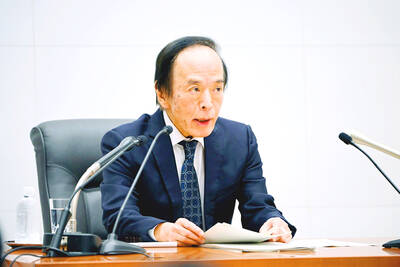DBS Bank Ltd (星展銀行) last week lowered its forecast for Taiwan’s GDP growth this year to minus-1 percent, down from the 0.9 percent growth the bank predicted on March 23, as the COVID-19 pandemic is projected to deal a serious blow to the nation’s exports.
“A decline in exports as a result of the lockdowns and shutdowns in Europe, the US and Southeast Asia is the biggest challenge facing the Taiwanese economy for the coming quarters,” DBS economist Ma Tieying (馬鐵英) said in a report on Wednesday.
“Taiwan’s exports, industrial production and purchasing managers’ index data held up well as of February and last month, but a sharp contraction could be expected ahead in the second and third quarters, when global recession, job losses and income declines start to emerge,” Ma said.
Singapore-based DBS’ forecast was more bearish than the 0.2 percent growth Moody’s Investors Service predicted on Monday last week.
The central bank on March 19 revised downward its GDP forecast this year to 1.92 percent, but some research institutes have placed their estimates at about 1 percent.
The latest government data released last week showed that Taiwan’s exports last month declined 0.6 percent from a year earlier to US$28.27 billion, while its combined exports in the first quarter expanded 3.7 percent year-on-year to US$78.7 billion.
The Taiwanese economy would fare better than during the global financial crisis of 2008 to 2009, DBS said, adding that electronics exports should remain relatively resilient, thanks to the rise in telecommuting and the resultant demand for laptops, tablets and other electronic devices.
“We also expect the economic losses in Taiwan to be smaller than that in Singapore, Hong Kong and South Korea,” Ma said, adding that the spread of COVID-19 in Taiwan is relatively under control in light of the government’s early response and its fast expansion of mask production capacity.
In addition, Taiwan’s domestic transport, retail and recreation, and work activities also remained at about 75 percent, 90 percent and 100 percent respectively of normal levels as of the end of last month, making it one of the highest in Asia, she said, citing Google’s COVID-19 Community Mobility Report.
DBS has also trimmed its GDP growth forecast for South Korea from 0.8 percent to minus-1.1 percent for the same reasons, meaning that South Korea’s economic performance this year would likely be worse than in the global financial crisis.
Singapore’s GDP growth estimate has been further lowered to minus-2.8 percent and Hong Kong’s growth has been downgraded to minus-4 percent this year, which would be deeper than the Asia financial crisis and the global financial crisis, DBS said.

Taiwan Semiconductor Manufacturing Co (TSMC, 台積電) last week recorded an increase in the number of shareholders to the highest in almost eight months, despite its share price falling 3.38 percent from the previous week, Taiwan Stock Exchange data released on Saturday showed. As of Friday, TSMC had 1.88 million shareholders, the most since the week of April 25 and an increase of 31,870 from the previous week, the data showed. The number of shareholders jumped despite a drop of NT$50 (US$1.59), or 3.38 percent, in TSMC’s share price from a week earlier to NT$1,430, as investors took profits from their earlier gains

In a high-security Shenzhen laboratory, Chinese scientists have built what Washington has spent years trying to prevent: a prototype of a machine capable of producing the cutting-edge semiconductor chips that power artificial intelligence (AI), smartphones and weapons central to Western military dominance, Reuters has learned. Completed early this year and undergoing testing, the prototype fills nearly an entire factory floor. It was built by a team of former engineers from Dutch semiconductor giant ASML who reverse-engineered the company’s extreme ultraviolet lithography (EUV) machines, according to two people with knowledge of the project. EUV machines sit at the heart of a technological Cold

TAIWAN VALUE CHAIN: Foxtron is to fully own Luxgen following the transaction and it plans to launch a new electric model, the Foxtron Bria, in Taiwan next year Yulon Motor Co (裕隆汽車) yesterday said that its board of directors approved the disposal of its electric vehicle (EV) unit, Luxgen Motor Co (納智捷汽車), to Foxtron Vehicle Technologies Co (鴻華先進) for NT$787.6 million (US$24.98 million). Foxtron, a half-half joint venture between Yulon affiliate Hua-Chuang Automobile Information Technical Center Co (華創車電) and Hon Hai Precision Industry Co (鴻海精密), expects to wrap up the deal in the first quarter of next year. Foxtron would fully own Luxgen following the transaction, including five car distributing companies, outlets and all employees. The deal is subject to the approval of the Fair Trade Commission, Foxtron said. “Foxtron will be

INFLATION CONSIDERATION: The BOJ governor said that it would ‘keep making appropriate decisions’ and would adjust depending on the economy and prices The Bank of Japan (BOJ) yesterday raised its benchmark interest rate to the highest in 30 years and said more increases are in the pipeline if conditions allow, in a sign of growing conviction that it can attain the stable inflation target it has pursued for more than a decade. Bank of Japan Governor Kazuo Ueda’s policy board increased the rate by 0.2 percentage points to 0.75 percent, in a unanimous decision, the bank said in a statement. The central bank cited the rising likelihood of its economic outlook being realized. The rate change was expected by all 50 economists surveyed by Bloomberg. The